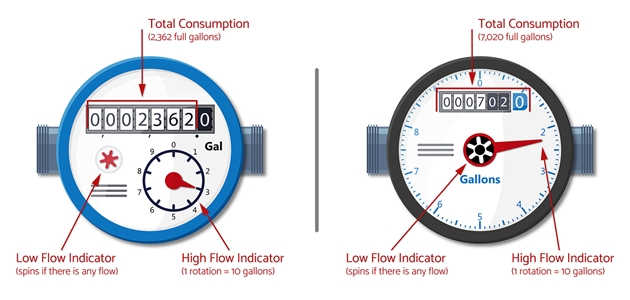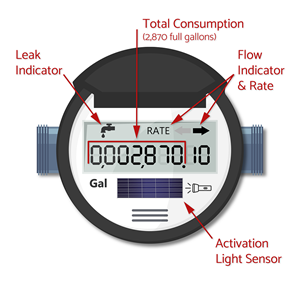Water Meters & Leak Detection
Your water meter is a simple and reliable instrument that measure the volume of water (in gallons) that has passed from the public watermain to your home or business. It allows us to accurately charge individual users for their water use. Meters measure all water flow, so they can be used to detect even the smallest leaks in your plumbing – to help you conserve water and save money.
Locating and Reading Your Water Meter
 The location and appearance of residential water meters varies, but they’re all similar in their function. Commercial installations may have more complex metering and are not covered here.
The location and appearance of residential water meters varies, but they’re all similar in their function. Commercial installations may have more complex metering and are not covered here.
Water meters are usually housed in a concrete or plastic box marked "WATER", found near the street at the front of a property, and often in line with the main outside faucet. Once located, remove the lid with a large flat screwdriver or similar tool. Insects and small animals like water meter boxes, so use caution when opening. Lift the protective cap on the meter by hand to reveal its face.
Analog Meters
There are several models of analog meters, with the two examples below being the most common. All show the same information in slightly different ways. Horizontal rotating numerals measure total volume – this is your meter reading in gallons. High Flow Indicators (large, red, clock-like dial) measure 10 gallons with each rotation. Star-shaped Low Flow Indicators spin at even the slightest movement of water through the meter and can be used for leak detection.

click to enlarge
Digital Smart Meters
The main difference and advantage of smart meters is that they can be “read” remotely, so meter reading personnel don’t need to come onto your property. But even though their appearance is different, digital meters can be read in the same way as analog meters.
When you first open the meter’s lid, the display will likely be off, but you can activate it by shining a bright flashlight or mobile phone light on its sensor.

click to enlarge
Comparing Meter Readings to Billing Amounts
When comparing readings you take from your meter, and amounts stated on your utility bill, keep in mind the dates of each reading may be different. Discrepancies will depend on the number of days in question and your consumption during this period.
If your reading is significantly higher than that of your bill, you should first think about what could have caused a recent increase in consumption. If there is nothing, consider doing a leak check.
If your reading is significantly lower than that of your bill, please contact Customer Service for help.
Water meters are exceptionally reliable and rarely the cause of consumption and billing discrepancies. They’re designed to under-register or stop registering water flow if they malfunction.
Using Your Water Meter to Detect Leaks
Your water meter provides a simple way to determine if you have leaks in your plumbing, and it only requires a little time and effort.
Analog Meters
- Turn off all faucets and water-using appliances, such as fridge ice makers, washing machines, and dishwashers.
- If either the High Flow or Low Flow Indicators are visibly moving; you clearly have a leak.
- If these indicators do not appear to move, you may still have a very slow leak. Record the meter reading and position of the High Flow hand or use a piece of tape to mark its position.
- Keep the water off and wait at least 30 minutes.
- Now reread the meter. If there is any change, you probably have a leak in your system.
Digital Meters
- Turn off all faucets and water-using appliances, such as fridge ice makers, washing machines, and dishwashers.
- Activate the meter’s display by shining a flashlight or mobile phone light at its face.
- Wait a few seconds for the display to fully activate. It will then display the meter reading.
- If water is flowing, the display will also flash between the reading and the RATE of flow in gallons per minute (gpm). If there is any flow during your test, you likely have a leak, and you’ll also know how big it is.
- Digital meters also record water flow over the previous 24 hours, in 15-minute intervals. If continuous flow is detected (unusual in most homes) it could be a leak. This is shown with a tap or water droplet symbol.
- Flashing Symbol – shows water was flowing during most 15-minute intervals in the last 24 hrs. This isn’t necessarily a leak, but does indicate a high frequency of flow.
- Solid Symbol – shows water was flowing continuously over the last 24 hours, with a high likelihood of a leak.

click to enlarge
Determine if the Leak is Inside or Outside the Home
Once you’ve determined you have a leak, you can go one step further to find if the leak is within your home’s plumbing, or in the Service Line that connects your home to the public watermain. These are often the source of leaks as they run underground and are susceptible to damage.
- Shut off the main water valve to your home. This valve should only be turned by hand. If it’s stuck you should have it inspected by a plumber, as forcing it could damage it or cause a rupture.
- Repeat the steps above depending on the type of meter you have.
- If a change in reading IS detected, you have a leak in the Service Line outside of the home.
- If a change in reading IS NOT detected, your leak is somewhere inside the home.
- If you cannot find and remedy the leak yourself, you should call a professional plumber, as leaks never get better.